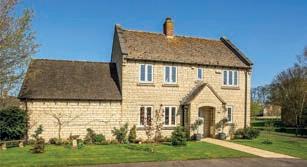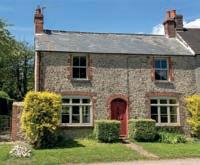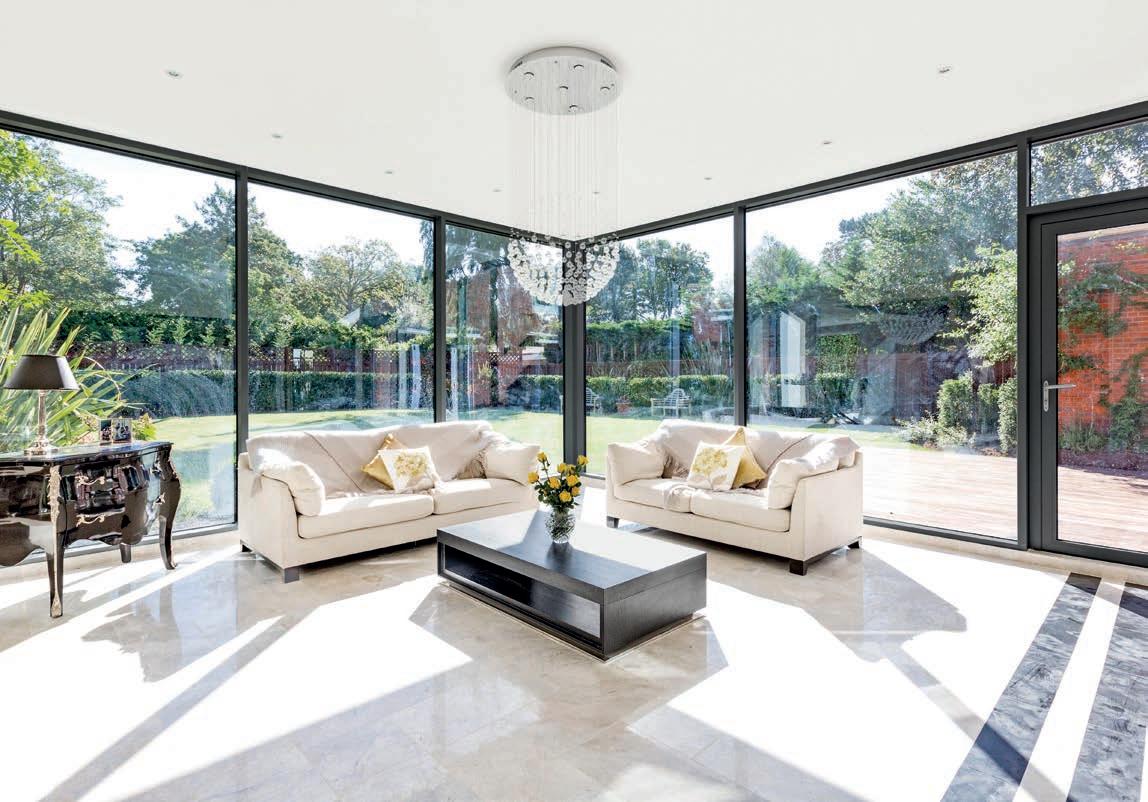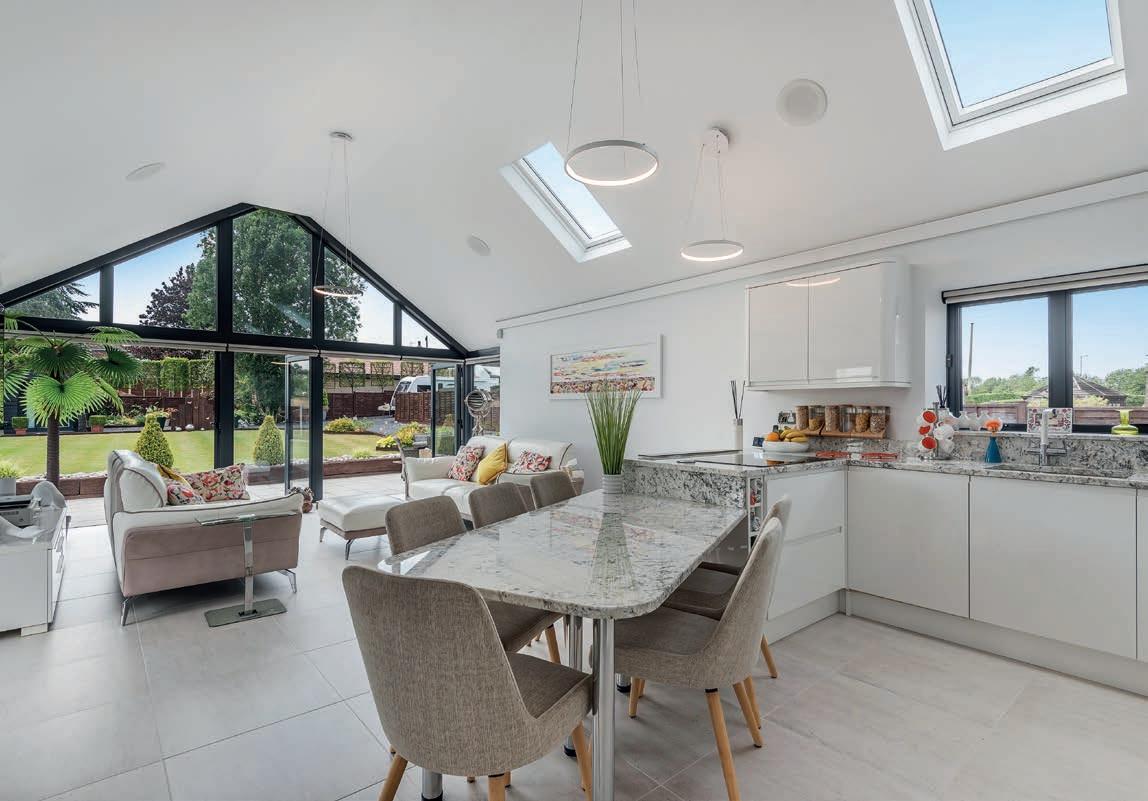COUNTRY MARKET COMMENT
Volumes and sentiment have proved significantly more buoyant than anticipated earlier in the year, even in those areas in which sales are taking longer.
LONDON MARKET COMMENT
Sterling’s weakness has helped prime central rents to grow and sales values to strengthen. Might many more overseas buyers be waiting in the wings?
NEW HOMES & DEVELOPMENTS
As the NHBC records the most new home registrations for 12 years, modern styles are attracting private buyers, whilst yields prompt more large scale build-to-rent projects.

N O 44 WWW. UKMARKETREVIEW .CO.UK 2019
Country Market Comment

"BEST EVER YEAR"
Northern offices lead the way in reporting better year-to-date figures than we had dared hope back in spring, despite universal caution at higher price levels and some head winds in the South East.

UK Market Review | N 0 44; 2019 3
Main photo: Kent POA (Cranbrook)
Front cover and left: Cornwall £2,250,000 guide (Truro)
Our Hale office has, at the time of writing, just completed its financial year – and it has been their best ever, for sales volumes and revenue, since opening in 2006. In their final week alone, Hale agreed no fewer than three sales following submissions of ‘best and final offers’ from competing buyers. Furthermore, for their colleagues nearby at JacksonStops Alderley Edge, and 65 miles north east in York, the picture is almost as positive.

JUST THE NORTH?
Remarkably, this is not just a northern phenomenon. Jackson-Stops offices from Norwich across to Truro have enjoyed a strong summer, with no shortage of buyers – indeed Ipswich, like Hale, looks like it might also notch up a record year. It is the case that sales are taking longer in the South East and recent ONS figures perhaps give a clue as to why: since the house price peaks of 2007, prices in few areas outside the South-East have recovered enough to cover general inflation over that time of, in total, some 38%. In contrast, even after recent falls, the average London house price is still some 55% above the 2007 peak and thus well ahead of inflation.
Coupled with gradual wage growth over the years, this means that homes are simply more affordable further away from London, both for locals and for those cashing in on the difference, by moving out. Regional demand is higher as a result.
Despite higher demand (mortgage approvals nationally are also slightly up) there is little pressure either way on prices which, as a broad generalisation, continue to creep upwards at the lowest price levels and downwards at the very


UK Market Review | N 0 44; 2019 4 5 UK Market Review | N 0 44; 2019
Country Market Comment
Berkshire
19 19 39 55 36 21 8 8 -8 NE NW York & Hum E Mids W Mids East London SE SW AGGREGATE INFLATION % PRICE GROWTH SINCE 2007 Source: ONS
Main photo: Lancashire £3,500,000 guide (Alderley Edge). Inset: York £1,150,000 guide (York)
£2,250,000 guide
TRANSPARENCY BEGETS TRUST
highest. These adjustments are so slight that, month-to-month, they are largely imperceptible, especially with regard to a typically unique country house. This inelasticity of prices is illustrated by one Exeter sale also just agreed at the time of writing, in which four would-be buyers of a £600,000 house submitted their best and final offers. All four were within £5,000 of each other. When the spread between competing bids is less than 1%, the message is clear: buyers know what properties are worth and they will not overpay.
TIME-RICH BABY BOOMER BUYERS
Who are these well-informed, poker-faced buyers?
The comment from Simon Milledge of our Blandford Forum office – which, after a slow spring, has had a tremendously busy summer – rings true for many others:
“Demand is highest for good family houses, but we rarely sell them to families. Most buyers are empty nesters and
baby boomers. They are serious about moving, but the classic time pressures just aren’t there.”
This is a key point. Today’s older buyers are not changing jobs or expecting a baby, so they have no deadline. Coupled with healthy but relatively fixed levels of income and equity, their incentive and ability to go above a genuine maximum, is tightly restricted. They also ask a lot more questions about maintenance costs and neighbours.
SOUTH EAST MARKET SHARE GROWTH
Even in the South East, the main issue has not been a shortage of buyers or stock, but the length of time taken for sales to go through (having a knock-on effect where sellers are buying in a different region).
There are numerous reasons behind this, but one positive effect for us has been a shift by sellers towards agents (and solicitors) whom they know will be highly proactive in both negotiating a deal and then nurturing it through to completion. This has enabled our south eastern offices to gain market share and thus maintain volumes even within slower markets. For the new Mid Sussex office, it has enabled them to go from zero-to-profitable in just a few months. To quote director Toby Whittome: “A tougher market is great for us because sellers abandon old relationships in favour of someone more effective. Personally, I never think one buyer is enough. You need at least two – then the whole dynamic changes and we get a chance to secure what really is, the best price.”
Above: Norfolk £1,250,000 guide (Norwich)

Bottom left: Newmarket £895,000 guide (Newmarket)

In any negotiation, though it’s natural to want to play your cards close to your chest, it is not always in your best interests.
In many regional markets, much current demand for country houses to rent is from tenants hoping to buy within a year (an existing trend fuelled, a little counter-intuitively, by a slower sales market in the South East). The problem is that it could be anything from four to twenty-four months before the tenant no longer needs the house, so no one can know when, and on whom, additional costs and stresses will arise. Worse if, as so often, it is assumed that the ideal rental term for the landlord is one cast in stone, whilst that for the tenant is ‘just as long as we need’, both sides start from a guarded position.

In practice, the situation is almost always more nuanced. What the landlord really wants is a responsible tenant and security of income, whilst the tenant simply wants a relatively modest degree of flexibility. Both sides often have other factors to consider, too, such as major maintenance works and school holidays. By revealing these and looking to accommodate each other’s requirements, simple arrangements such as tailored minimum notice periods, or taking income from re-letting into account and, most of all, frequent communication, can work wonders in facilitating agreement.
IMPACT OF TENANT FEE BAN
Lack of transparency and trust played a big part, too, in the saga of tenant fees and their banning from 1st June 2019. For us, the impact has been positive, because our offices either didn’t charge fees, or did so without using them as a source of income. Problems arose because of hidden profiteering. Faced with a more transparent market, tenants now approach it with greater confidence, which is good for all. Meanwhile, Jackson-Stops lettings teams whose rivals were relying on tenant fees for a big part of their income (Northampton appears to be a hot spot for this) are enjoying an influx of new business from landlords whose previous agents are trying to charge them more.
MODEST RENT RISES
As reported in earlier editions, with landlords facing extra costs, many industry professionals – including the RICS – had predicted that rents would rise sharply as a result. We questioned this and, indeed, have since seen rents rise essentially in line with inflation. Backing this up, according to the ONS, “Rental prices for the UK, excluding London, increased by 1.5% in the 12 months to June 2019.”
Opposite page:
Top: Kent £3,495 pcm (Cranbrook)

Bottom: Northampton £2,700 pcm (Northampton)
Real wage increases might soon fuel rent increases. This, though, underlines that it is what tenants will pay, not landlord costs, which sets rents. In a market as transparent as this one, the landlords and agents who prosper, are those whom tenants can trust.
7 UK Market Review | N 0 44; 2019 UK Market Review | N 0 44; 2019 6 Country Rentals
Country Market Comment
What will £500,000 buy in the country?
This page, anticlockwise from the left: North Yorkshire £475,000 guide (York)
Dorset £375,000 guide (Bridport)

South Norfolk £369,950 guide (Bury St Edmunds)

Oxfordshire £399,950 guide (Burford)

West Sussex £500,000 (Midhurst)
This page, clockwise from the right: Devon £485,000 guide (Exeter)
Dorset £435,000 guide (Shaftesbury)




Surrey £400,000 guide (Oxted)


West Sussex £525,000 guide (Chichester)
WHAT WILL £500,000 BUY IN THE COUNTRY?
More than double the current UK average house price of £230,000 (Land Registry), what half a million pounds secures, varies greatly across the country.
UK Market Review | N 0 44; 2019 8 9 UK Market Review | N 0 44; 2019 Examples from our offices outside London
London Market Comment
DOLLAR MOVERS IN THE WINGS?
Post 2014/15, the number of foreign investors moving to Britain – most with US$-based wealth – dropped 80%. Are they now returning?


11
Main photo: Kingston upon Thames, KT2 £11,500 pcm (Wimbledon)
Right: St. Georges Square, SW1 £1,250,000 guide (Pimlico)
Ask commentators about the cause of London price reductions post-2014 and most will point to tax increases designed by George Osborne to take the heat out of the top end of the London market: stamp duty, a new annual property tax (ATED) and extra taxes for private landlords. These factors coincided, though, with numerous others, including new anti-money laundering laws. Together, these led to a reduction,
according to Home Office figures, of over 80% in the number of foreign investors moving to Britain in the year to March 2016. The gushing flow of foreign money pouring in to central London and rippling out as sellers took their gains elsewhere, stopped. Prices – rents and capital values – inevitably fell.
The picture today is very different. Since 2014, the US dollar has risen almost 30% against sterling. Prime London rents are down anything from 5% to 20% and capital values, anything from 10% to 30%. If your money is in dollars, this makes a huge difference: an apartment which would have been, in 2014, $1,900 per week, now equates to around $1,200 per week. Even more spectacular, a house for sale in 2014 at say, $8.5 million, would now cost around $4.8 million. Not quite half price, but close. Unsurprisingly, our dollar-based tenants and buyers are much happier and we have no doubt that this is a factor in rents and capital values increasing. We firmly expect rental demand to grow further. Much less certain is whether dollar-based buyers are now held back by the legislative changes referred to above, or whether they are waiting for a measure of political certainty (a big part of the appeal of London having always been its solid, safe haven status). If they are awaiting greater political certainty then, if and when it is regained, they will look to act swiftly, before prices and exchange rates erode their current advantage.
LETTINGS: A NEW STABILITY

There remains strong demand at the top end of the rental market and at all rent levels. Landlords, far from being discouraged from continuing with their letting investment, have been retaining or even growing their portfolios. The fact is that despite lower returns, there are still few better investments. We are witnessing a stronger market which may well see the year end with a modest jump in central London rents. Across central and more suburban

UK Market Review | N 0 44; 2019 12 13 UK Market Review | N 0 44; 2019
London Market Comment
Main photo: Weybridge KT13 £699,950 guide (Weybridge)
Right: Richmond TW9 £2,950 pcm (Richmond)
markets, demand is healthy and the number of deals done, for us at least, is greater than last year. Looking ahead, we are watching the student market (which, again, is important in all areas) and at what the impact of growing institutional investment in large scale ‘build to rent’ projects might be.
SALES: STRONG WHERE THE BRITS ARE
Prices in central London are holding firm. In areas favoured by overseas and ‘top 1%’ buyers, this is at


THE LAST BRITISH VERNACULAR?
For eighty years, no ‘era defining’, new house style has endured. Will those of the early 20th century prove to be an increasingly treasured ‘last hurrah’ of British vernacular?
least partly because availability is so low. Outside such exclusive areas, prices are holding firm because the demand is there. Selling prices on deals agreed via our Pimlico and Westminster office, for example, have so far this year averaged 98% of asking price, with volumes on a par with last year. Looking south west (which does have its share of top 1% buyers, mainly for the most favoured SW19 Common-side spots and the dizziest heights of St George’s Hill) the picture is similar. Sales are tending to take longer, because this is more of a family market with the dependent sales, mortgages and ‘off-stage’ disruptions which that involves. Yes, the spark of a boom market, boosted by overseas money flowing from the centre of town is not there. But it remains positive, driven by normal people needing to buy and sell in the normal way.
Post-war homes, many built when time, money and materials were short, have not lasted. So many have been replaced that in London and, increasingly, elsewhere, the choice is between period or very recently built homes. The latter, despite the valiant attempts of a few architects and builders, tend to be either straight copies of period designs, or glassand-steel structures which can be beautiful at small scale but which, at any size, are just too hard for British landscapes.
A hundred years ago, our domestic architecture was admired around the world. The religiosity of the Gothic Revival had relaxed into a comfortable grand-cottagelike character. Architects such as Lutyens and Baillie Scott, inspired by Morris (see back page), looked to craftsmanship and forms derived from observation of landscape and traditional building techniques. These ideals shaped the early 20th century houses
that still make such good homes today.
This is exemplified in the fabulous authenticity of properties such as the Art & Crafts house shown above. The point is made, too, by the Queen Anne house shown below. Faced with the lack of recent vernacular styles on which to draw, its modernisers have, understandably, opted for predominately glass additions in the light-touch, essentially internationalist style which modern materials allow. Might a new British vernacular emerge? Form often follows function, so efforts to change building regulations and techniques to allow larger scale modular and prefabricated construction might one day herald a new era. In the meantime, our appreciation of classic early 20th century houses and others true to their period, will only grow.


UK Market Review | N 0 44; 2019 14 Notes on Architecture
15
West Sussex £1,300,000 guide (Arundel)
UK Market Review | N 0 44; 2019
A 1927 Art & Crafts house designed by a pupil of Lutyens, now on the market for the very first time.
London Market Comment
North Yorkshire Excess £2,500,000 (York) Modernised Queen Anne house in 14 acres.
Above: Warwick Square, SW1 £3,500,000 guide (Pimlico)
Left: Mayfair, W1 £6,283 pcm (Mayfair)
BROAD STRENGTH
A market characterised by growth and confidence is all the more remarkable for its breadth, as well-heeled older buyers opt for modern convenience and younger ones continue to take advantage of Help to Buy.


UK Market Review | N 0 44; 2019 17
Main photo: Bedfordshire £625,000 guide (Woburn)
New Homes & Developments UK Market Review | N 0 44; 2019 16
Left: Exeter £645,000 guide (Exeter)
New Homes and Developments
Good news abounds on the new homes front, both within the various JacksonStops new homes teams across the country and in the figures reported by our national institutions. Exeter’s Louisa Hooper, for example, reports such strong demand for one up-market Dart Valley development, she is securing off-plan sales on houses which will not be built until October 2020. Similarly, some 200 miles east of the Dart Valley, houses in the first phase of Surrey’s newest Garden Village, Upper Longcross near Chobham, have sold out ahead of schedule and predominantly off-plan. This impressive result is not, it should be added, wholly thanks to general market forces: design decisions by its developers, Crest Nicholson, such as opting for flexible, partially open-plan layouts, a great variety of styles and finishes, plus exteriors which are strikingly modern without going too far, have generated real excitement and enthusiasm amongst buyers.

These positive local reports tie in with national ones. Mortgage approvals are up (UK Finance) and
the confidence of UK house builders is at its highest level since 2017 (Home Builders Federation). For its part, the NHBC reported in August that, in the previous quarter, housebuilders registered the highest number of new homes for 12 years, up 12% on the same period last year.

BREADTH OF DEMAND
We are seeing a continuance of the trend for rurallybased older buyers within any given region, to sell their ‘rustic pile’ in favour of a brand new, more manageable house close to amenities. These are favoured, too, by buyers moving in, often from the South East, who frequently sell first, then rent and buy at leisure. This is behind the readiness of some to buy the right house off-plan, even if that means waiting for a year to move in.
Meanwhile, at lower price levels, Help to Buy continues to feature strongly, especially with first time buyers. Figures released by UK Finance over the summer show a rise in the number of first time
Above: Upper Longcross, Chobham KT16, from £875,000 (Weybridge)

Below: Chichester £675,000 guide (Chichester)
LANDLORDS CONSIDER THEIR OPTIONS
Mortgage products proliferate as landlords fight to preserve after-tax income.
LIMITED COMPANIES
buyers (up 8% on last year) and as a proportion of all buyers. They now outnumber buy-to-let purchases nearly six to one. Structurally, this has to be good for the market.
NEW BUILD RENTAL GROWTH
The NHBC report also emphasised the extent to which the private rental sector is boosting new home registrations. Historically, large scale private landlords have been a rarity in the UK. This is changing. In London, for example, researchers Molior report that ‘Build to Rent’ units accounted for 18% of Q2 sales across larger London projects. Legal & General’s Affordable Homes business says it will be providing 3,000 homes pa within four years, and the number of local authorities with development companies designed for joint ventures with private developers has risen 57% since 2017. Indeed, Worthing council has signed a deal with the IKEA/Skanska company BoKlok – which specialises in factory-built housing – to build 162 flats there. Such schemes are often testbeds for innovation so, given our positive experience at Upper Longcross and elsewhere, this is something we welcome and shall be watching with interest.
In a bid to hold onto their mortgage interest tax reliefs, many landlords are now choosing to purchase via limited company structures. These can still claim the tax relief and are especially attractive to higher rate tax payers. Lenders are doing everything they can to accommodate them, and there are now more limited company buy-to-let mortgages available than ever before.
HOLIDAY BUY-TO-LETS
Holiday property investments are exempt from the 2017 tax relief changes and generally command much higher weekly rents. Keeping the property occupied year-round is much harder, but for those with an appetite for the work, holiday lets are often an attractive investment opportunity.
HOUSES IN MULTIPLE OCCUPATION
Research released by Leeds Building Society showed that the rental yields of houses in multiple occupation (HMOs) are higher than those of any other property type, attracting much attention to the sector. Historically, lenders were wary to lend on such property, looking carefully at the number and type of tenants, the value and location of the property, and lending only to applicants who satisfied stringent criteria, such as a track record in the sector. Those criteria remain strict, but the range of HMO mortgage products has increased a great deal. This has opened up opportunities for landlords who previously might have had difficulty securing finance for an HMO investment.
RENOVATIONS
Products are now available that provide shortterm funding to landlords looking to renovate their properties prior to renting. This allows them to boost yield and capital value before then switching to a standard buy-to-let mortgage.
For independent advice, contact Private Finance on 0870 600 1650 or jackson-stops@privatefinance.co.uk.
UK Market Review | N 0 44; 2019 UK Market Review | N 0 44; 2019
Private Finance
www.privatefinance.co.uk
Below: Suffolk POA (Ipswich)
18
An award-winning architectural historian, Clive is acknowledged as a leading authority on Britain and its way of life. Editor of Country Life for over 12 years he now writes for it and for newspapers such as The Times, as well as broadcasting on radio and television. His non-fiction books include The Last Country Houses and The American Country House, both for Yale University Press. His first novel, The Birdcage, was published in 2014.
WILLIAM MORRIS: HEART & HOME
Clive Aslet
The Arts & Crafts movement was a noble attempt to stop the modern world in its tracks. It failed, overwhelmed by the public’s desire to buy gewgaws made in Birmingham factories, rather than expensive products made beautifully, by hand. And yet the burly and exuberant William Morris, his austere architect friend Philip Webb and the host of idealistic craftsmen and simpler lifers who followed them did bequeath one idea to the 21st century: the sanctity and centrality of Home.
Morris was an irresistible figure. When he was not writing epic poetry, he was weaving textiles; when not weaving, he was lecturing on socialism – or writing utopian tracts, or founding the Society for the Protection of Ancient Buildings, or designing wallpaper. The nail which stablised this fizzing Catherine wheel of energy was the home.
Famously, Morris designed his own home, Red House*, built in 1859, when he was 25 and newly married to Jane Burden. Artist friends painted murals and designed stained glass windows, hangings and tiles. Overflowing with hospitality, he would appear from the cellar with bottles of wine under each arm and more in his hands, before sitting down at a table equipped with an iron rim, to baffle his restless habit of whittling the furniture while waiting for food. A fight with apples once gave him a black eye.
It wasn’t a comfortable house and Morris had to abandon it to spend more time in London. Later, he fell in love with an old grey manor house on the banks of the Thames, in Oxfordshire. Kelmscott Manor seemed to have ‘grown up out of the soil,’ he once observed. He lent its name to Kelmscott House, the terraced house of around 1790 in Hammersmith, where he had the press on which his magnificent Kelmscott Press books were printed. He believed that ‘the most important production of art’ was ‘a beautiful House,’ followed by ‘a beautiful Book.’
His passion lives on. One of the National Trust’s recent acquisitions is Stoneywell Cottage, in Leicestershire, designed by Ernest Gimson –an architect who threw over an architectural career in London to live frugally in the Cotswolds – for his brother, Sydney. Built from enormous boulders, one whole end is taken up with a massive chimney breast – the hearth was an important symbol in Arts & Crafts iconography. The two "dear giants" of workmen who built it bore the (now) regal names of William and Harry. Begun in 1899, it was absurdly inconvenient: there was no electricity, no running water, no central heating – all of which had become standard. But it had heart. As the world roars on at an ever more bewildering pace, I can’t help feeling those hopeless idealists of the Arts & Crafts Movement got some things right.

Home
ukmarketreview.co.uk | jackson-stops.co.uk | Edited and produced by BlueMoonCreative.co.uk SALES | LETTINGS | NEW HOMES
EXPERTS SINCE 1910 West Country Barnstaple 01271 325153 Blandford 01258 433002 Bridport/Dorchester 01308 423133 Exeter 01392 214322 Shaftesbury 01747 850858 Sherborne 01935 810141 Taunton 01823 325144 Truro 01872 261160 Cotswolds, Hereford & Worcs Burford 01993 822661 Chipping Campden 01386 840224 Cirencester 01285 653334 London Chelsea 020 7581 5881 Holland Park 020 7727 5111 Mayfair 020 7664 6644 Pimlico 020 7828 4050 Richmond 020 8940 6789 Teddington 020 8943 9777 Weybridge 01932 821160 Wimbledon 020 8879 0099 Central Northampton 01604 632991 Woburn 01525 290641 Country Houses 020 7664 6646 New Homes 020 7664 6649 South East Canterbury 01227 781600 Cranbrook 01580 720000 Dorking 01306 887560 Mid Sussex 01444 484400 Oxted 01883 712375 Reigate 01737 222027 Sevenoaks 01732 740600 Tunbridge Wells 01892 521700 South Arundel 01903 885886 Chichester 01243 786316 Midhurst 01730 812357 Winchester 01962 844399 East Anglia Burnham Market 01328 801333 Bury St Edmunds 01284 700535 Chelmsford 01245 806101 Ipswich 01473 218218 Newmarket 01638 662231 Norwich 01603 612 333 North West & North Wales Alderley Edge 01625 540340 Chester 01244 328361 Hale 0161 9288 881 Yorkshire & North East York 01904 625033
PROPERTY
*Jackson-Stops advised on the transfer of Red House from the estate of its last private owners to the National Trust.

































